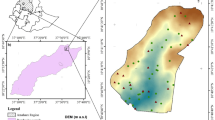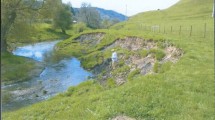Abstract
The rapidly increasing population of urban centers leads to the increasing need for greenspaces. Sodding of turfgrass provides instant greenspace, but it removes soil from sod farms. The extent of such removal has not been widely quantified. The amount quantity of soil and organic matter lost with sod harvest and the associated cost of nutrients lost from six sod farms in the Marmara region of Turkey were determined. Soil loss ranged from 166 to 243 Mg ha−1 year−1, while the associated organic matter loss ranged from 1 to 6 Mg ha−1 year−1. The amount of soil loss increased with increases in gravimetric water, clay, and silt contents, and duration under sod harvest, while it decreased with an increase in sand content. Annual nutrient lost ranged from 117 to 449 kg ha−1 for N, from 2 to 18 kg ha−1 for P2O5, and from 21 to 175 kg ha−1 for K2O. Replacing the nutrient lost would cost about $134 ha−1 year−1 for sandy soils and $444 ha−1 year−1 for fine-textured soils. Soil lost with sod harvest was 134 times higher than that from agricultural lands by erosion in the region, although the area under sod production is much smaller than that under croplands. Similarly, organic matter loss was 4 to 5 times higher than the accumulation rate under established turfgrass in golf courses and lawns in locations with similar climate. Overall, sod harvesting results in significant and costly soil, organic matter, and nutrient loss, which, although small in area, can be an important component of total soil erosion.



Similar content being viewed by others
References
Acar, R., & Dursun, S. (2010). Vegetative methods to prevent wind erosion in central Anatolia region. International Journal of Sustainable Water & Environmental Systems, 1(1), 25–28.
Beard, J. B., & Green, R. L. (1994). The role for turfgrasses in environmental protection and their benefits to humans. Journal of Environmental Quality, 23, 452–460.
Berberoglu, S., Cilek, A., Kirkby, M., Irvine, B., & Donmez, C. (2020). Spatial and temporal evaluation of soil erosion in Turkey under climate change scenarios using the Pan-European Soil Erosion Risk Assessment (PESERA) model. Environmental Monitoring and Assessment, 192, 491. https://doi.org/10.1007/s10661-020-08429-5.
Blake, G. R., & Hartge, K. H. (1986). Bulk density. In: Klute, A. editor, Methods of soil analysis: part I. Physical and minerological methods. ASA, SSSA, Madison. p. 363-375.
Blanco-Canqui, H., & Lal, R. (2008). Principles of soil conservation and management. Heidelberg: Springer.
Borrelli, P., Robinson, D. A., Fleischer, L. R., Lugato, E., Ballabio, C., Alewell, C., Meusburger, K., Modugno, S., Schutt, B., Ferro, V., Bagarello, V., Van Oost, K., Montanarella, L., & Panagos, P. (2017). An assessment of the global impact of 21st century land use change on soil erosion. Nature Communications, 8, 1–13.
Bremner, J. M., & Mulvaney, C. S. (1982). Nitrogen-total. In: Page, A.L, Miller, R.H. and Keeney, D.R. editors, Methods of soil analysis: part II. Chemical and microbiological properties. ASA, SSSA, Madison. p.539-579.
Burls, A. (2007). People and green spaces: promoting public health and mental well-being through ecotherapy. Journal of Public Mental Health, 6, 24–39.
Chawla, S. L., Roshni, A., Patel, M., Patil, S., & Shah, H. P. (2018). Turfgrass: a billion dollar industry. National Conference on Floriculture for Rural and Urban Prosperity in the Scenerio of Climate Change-2018.
Chen, J. (2007). Rapid urbanization in China: a real challenge to soil protection and food security. Catena, 69, 1–15.
Deloya, M. C. (1993). Urban forestry in Mexico City. Unasylva, 173, 28–32 https:// www.fao.org/3/u9300e/u9300e06.htm (accessed 12 June 2019).
DMI. (2016). Turkish State Meteorological Service. Meteorological bulletin (in Turkish). https://www.mgm.gov.tr/ (accessed 5 July 2019).
Gee, G. W., & Or, D. (2002). Particle-size analysis. In: Dane, J.H. and Topp, G.C. editors, Methods of soil analysis. Part IV: physical methods. SSSA Book Ser. 5. SSSA, Madison. p. 255-293.
Griffith, S., Bero, N., Stier, J., Obear, G., Ruis, S. J., & Soldat, D. (2020). Use of biosolids for sod production: impact on the import/export of nutrients, heavy metals, and soil mineral matter. Agronomy Journal. https://doi.org/10.1002/agj2.20086.
Haydu, J. J., Hodges, A.W., & Hall, C.R. (2006). Economic impacts of the turfgrass and lawn care industry in the United States. Food and Resource Economics Dep. Inst. of Food and Agric. Sci., Univ. of Florida, Gainesville.
Isabirye, M. G., Ruysschaert, L., Van Linden, J., Poesen, M. K., Magunda, & Deckers, J. (2007). Soil losses due to cassava and sweet potato harvesting: a case study from low input traditional agriculture. Soil & Tillage Research, 92, 96–103.
Kemper, W.D., & Rosenau, R.C. (1986). Aggregate stability and size distribution. In: Klute, A. editor, Methods of soil analysis: part I. Physical and minerological methods. ASA, SSSA, Madison. p. 425-442.
Kibet, L. C., Blanco-Canqui, H., & Jasa, P. (2016). Long-term tillage impacts on soil organic matter components and related properties on a Typic Argiudoll. Soil & Tillage Research, 155, 78–84.
Knudsen, D., Peterson, G. A., & Pratt, P. F. (1982). Lithium, sodium, and potassium. In: Page, A.L., Miller, R.H. and Keeney, D.R. editors. Methods of soil analysis. Part II: chemical and microbiological properties. SSSA, Madison. p.225-245.
Liang, B. C., VandenBygaart, A. J., MacDonald, J. D., Cerkowniak, D., McConkey, B. G., Desjardins, R. L., & Angers, D. A. (2020). Revisiting no-till’s impact on soil organic carbon storage in Canada. Soil & Tillage Research, 198, 104529.
Lima, C. P., Marques Santos, A. J., Villas Boas, R. L., Fernandes, D. M., Godoy, L. J. G., & Oliveira, M. R. (2018). Sod production and the effects of liquid organo-mineral fertilizers and thickness of sod. Scientia Agricola, 75, 346–353.
Milesi, C., Running, S. W., Elvidge, C. D., Dietz, J. B., Tuttle, B. T., & Nemani, R. R. (2005). Mapping and modeling the bioghemical cycling of turf grasses in the United States. Environmental Management, 36, 426–438.
Millar, D., Stolt, M., & Amador, J. A. (2010). Quantification and implications of soil losses from commercial sod production. Soil Science Society of America Journal, 74(3), 892–897.
Ministry of Agriculture and Forestry. (2017). Statistics for annual ryegrass seed production and imports (in Turkish). https://www.tarimorman.gov.tr/Konular/Bitkisel- Uretim/Tohumculuk/Tohumculuk-Istatistikler (accessed 5 June 2019).
Nelson, R. E., & Sommers, L. E. (1982). Total carbon, organic carbon and organic matter. In: Page, A.L., Miller, R.H. and Keeney, D.R. editors. Methods of soil analysis. Part II: chemical and microbiological properties. SSSA, Madison. p. 539-579.
Olsen, S. R., & Sommers. L. E. (1982). Phosphorus. In: Page, A.L., Miller, R.H. and Keeney, D.R editors. Methods of soil analysis. Part II: chemical and microbiological properties. SSSA, Madison. p. 403-427.
Ozdemir, S., Nuhoglu, N. N., Dede, O. H., & Yetilmezsoy, K. (2020). Mitigation of soil loss from turf grass cultivation by utilizing poultry abattoir sludge compost and biochar on low-organic matter soil. Environmental Technology, 41, 466–477.
Parlak, M., Palta, Ç., Yokuş, S., Blanco-Canqui, H., & Çarkacı, D. A. (2016). Soil losses due to carrot harvesting in south central Turkey. Catena, 140, 24–30.
Paustian, K. O., Andren, H. H., Janzen, R., Lal, P., Smith, G., Tian, H., Tiessen, M., van Noordwijk, M., & Woomer, P. (1997). Agricultural soil as a C sink to offset CO2 emissions. Soil Use and Management, 13, 230–244.
Poeplau, C., & Don, A. (2015). Carbon sequestration in agricultural soils via cultivation of cover crops-a meta-analysis. Agriculture Ecosystems & Environment, 200, 33–41.
Ruis, S. J., & Blanco-Canqui, H. (2017). Cover crops could offset crop residue removal effects on soil carbon and other properties: a review. Agronomy Journal, 109, 1785–1805.
Qian, Y. L., & Follett, R. F. (2002). Assessing soil carbon sequestration in turfgrass systems using long-term soil testing data. Agronomy Journal, 94, 930–935.
Qian, Y. L., Bandaranayake, W., Parton, W. J., Mecham, B., Harivandi, M. A., & Mosier, A. R. (2003). Long-term effects of clipping and nitrogen management in turfgrass on soil organic carbon and nitrogen dynamics: the CENTURY model simulation. Journal of Environmental Quality, 32, 1694–1700.
Qian, Y., Follett, R. F., & Kimble, J. M. (2010). Soil organic carbon input from urban turfgrasses. Soil Science Society of America Journal, 74, 366–371.
SAS Institute Inc. (2018). SAS/Entreprise Guide Version 9.4.
Schertz, D. L., & Nearing, M. A. (2002). Erosion tolerance/soil loss tolerances. In Encyclopedia of soil science. New York: Marcel Dekker Inc.
Schulte, E. E., & Hopkins, B. G. (1996). Estimation of soil organic matter by weight loss-on-ignition. In F. R. Magdooff, M. A. Tabatabai, & E. A. Hanlon (Eds.), Soil organic matter: analysis and interpretation (pp. 21–31). Madison: SSSA.
Shen, W., Wu, J., Grimm, N. B., & Hope, D. (2007). Effects of urbanization-induced environmental changes on ecosystem functioning in the Phoenix Metropolitan Region, USA. Ecosystems, 11, 138–155.
SODSAT. (2018). Remote precision management of turf grass sod production by means of artificial intelligence and satellite imaging. SODSAT Project Final Report Summary. European Community’s Seventh Framework Programme Project number 605729. Malta.
Soil Taxonomy. (1999). A basic system of soil classification for making and interpreting soil surveys. USDA Natural Resources Conservation Service. Agriculture Handbook Number 436.
Stockmann, U., Minasny, B., & McBratney, A. B. (2014). How fast does soil grow? Geoderma, 216, 48–61.
TAU. 2018. Australian Turf Industry Study Tour. Turf industry data sheet of Australia. https://www.turfaustralia.com.au/aboutus/facts-figures (accessed 2 June 2019).
Tesfamariam, E. H., Annandale, J. G., Steyn, J. M., & Stirzaker, R. J. (2009). Exporting large volumes of municipal sewage sludge through turfgrass sod production. Journal of Environmental Quality, 38, 1320–1328.
Topp, G. C., & Ferre, P. A. (2002). Water content. In: Dane, J.H. Topp, G.C. editors, Methods of soil analysis: part IV. Physical methods. SSSA Book Ser. 5. SSSA, Madison. p.417-545.
Turgeon, A. J. (2005). Turfgrass management (7th ed.). Upper Saddle River: Prentice Hall.
UN-Habitat. (2001). United Nations Human Settlement Programme https://www.unhabitat.org/year/2001(accessed 2 June 2019).
UNDESA. (2018). United Nations Department of Economic and Social Affairs. United Nations-Population Division. World Urbanization Prospects: The 2018 Revision. Key Facts. https://population.un.org/wup/Publications/Files/WUP2018-KeyFacts.pdf (accessed 24 May 2019).
Van den Berg, A. E., Hartig, T., & Staats, H. (2007). Preference for nature in urbanized societies: stress, restoration, and the pursuit of sustainability. Journal of Social Issues, 63, 79–96.
Van den Berg, M. M., van Poppel, I., van Kamp, S., Andrusaityte, B., Balseviciene, M., Cirach, A., Danileviciute, N., Ellis, G., Hurst, D., Masterson, G., Smith, M., Triguero-Mas, I., Uzdanaviciute, P., de Wit, W., van Mechelen, C., Gidlow, R., Grazuleviciene, M. J., Nieuwenhuijsen, Kruize, H., & Maas, J. (2016). Visiting green space is associated with mental health and vitality: a cross-sectional study in four European cities. Health & Place, 38, 8–15.
Acknowledgments
The authors would like to thank the sod producers for the use of their sod farms for this study.
Author information
Authors and Affiliations
Corresponding author
Additional information
Publisher’s note
Springer Nature remains neutral with regard to jurisdictional claims in published maps and institutional affiliations.
Rights and permissions
About this article
Cite this article
Parlak, M., Everest, T., Ruis, S.J. et al. Impact of urbanization on soil loss: a case study from sod production. Environ Monit Assess 192, 588 (2020). https://doi.org/10.1007/s10661-020-08549-y
Received:
Accepted:
Published:
DOI: https://doi.org/10.1007/s10661-020-08549-y




